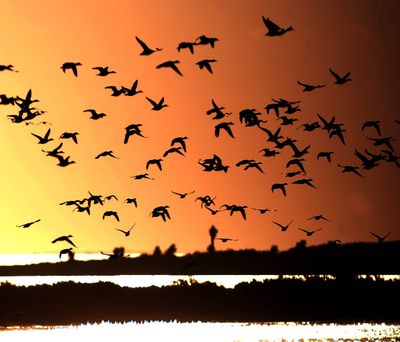Waterfowl will get crude reception during winter migration to Gulf

MINNEAPOLIS – A time bomb is ticking for loons and many other iconic birds that spend part of the year in Minnesota, Wisconsin and Canada before migrating south each fall.
As black crude continues to gush into the Gulf of Mexico, contaminating some of the continent’s richest wildlife habitat, officials fear an oily death could await untold numbers of Minnesota’s beloved 12,000 loons and other birds such as great blue herons, white pelicans, spotted sandpipers, egrets and ducks when they migrate south in a few months.
Even if the oil stops flowing soon, vast contaminated areas likely will remain this fall, meaning birds that migrate to or through the Gulf could fly into a deathtrap.
“Loons and lots of other species will be really vulnerable,” said Carrol Henderson, head of the Minnesota Department of Natural Resources’ non-game wildlife program.
An estimated 13 million ducks and 1.5 million geese winter along the Gulf Coast. Blue-winged teal and wood ducks will begin flying south as soon as August. Sandpipers start migrating in July. Loons depart in late October or November.
They are part of the flood of migratory birds that funnels along the Mississippi River to the Gulf Coast and beyond.
“This is a tragedy, not only for Gulf states, but the entire continent,” said Rich Baker, a DNR wildlife biologist.
Scientists say it’s impossible to predict how many birds might succumb to one of the nation’s biggest environmental disasters, what the impact will be to populations or how long the Gulf Coast might be fouled. One thing is apparent: The tragedy will take many months to unfold and likely will affect wildlife the width of the country and into Canada.
“It’s like a slow-moving train wreck, and the brakes haven’t been applied,” said Doug Inkley, senior scientist with the National Wildlife Federation in Washington, D.C. “This is a disaster in which we’re almost helpless to do anything.”
“You can’t slow, stop or divert the migration,” Henderson said. “The birds are pretty much hard-wired to go where they want to go.”
Ducks Unlimited has been awarded a $2.5 million grant from the National Fish and Wildlife Foundation (NFWF) to give some of the water-oriented birds a chance by quickly providing additional safe wetlands near the Gulf Coast.
The money comes from BP’s fund of income from oil recovered from the Deepwater Horizon oil spill.
DU plans to restore and enhance upwards of 20,000 acres of wetland habitat on lands adjacent to or near Gulf Coast marshes by flooding alternative habitats in the critical rice region of coastal Louisiana and Texas.
Minnesota researchers say their main hope is that about a third of the loons winter on the Atlantic Coast, where oil doesn’t appear to be an issue.
However, if significant numbers die in pools of oil, recovery of the loon population could be slow. Loons usually produce only one, sometimes two, chicks per season.